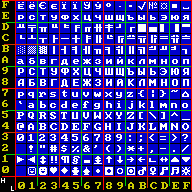Extended Binary Coded Decimal Interchange Code is an eight-bit character encoding used mainly on IBM mainframe and IBM midrange computer operating systems. It descended from the code used with punched cards and the corresponding six-bit binary-coded decimal code used with most of IBM's computer peripherals of the late 1950s and early 1960s. It is supported by various non-IBM platforms, such as Fujitsu-Siemens' BS2000/OSD, OS-IV, MSP, and MSP-EX, the SDS Sigma series, Unisys VS/9, Unisys MCP and ICL VME.

SmartSuite is a discontinued office suite from Lotus Software. The company made versions of its office suite for IBM OS/2 and Microsoft Windows.

In computing, internationalization and localization (American) or internationalisation and localisation (British), often abbreviated i18n and l10n respectively, are means of adapting computer software to different languages, regional peculiarities and technical requirements of a target locale.
Big-5 or Big5 is a Chinese character encoding method used in Taiwan, Hong Kong, and Macau for traditional Chinese characters.

Windows-1252 or CP-1252 is a single-byte character encoding of the Latin alphabet that was used by default in Microsoft Windows for English and many Romance and Germanic languages including Spanish, Portuguese, French, and German. This character-encoding scheme is used throughout the Americas, Western Europe, Oceania, and much of Africa.
ISO/IEC 8859-8, Information technology — 8-bit single-byte coded graphic character sets — Part 8: Latin/Hebrew alphabet, is part of the ISO/IEC 8859 series of ASCII-based standard character encodings. ISO/IEC 8859-8:1999 from 1999 represents its second and current revision, preceded by the first edition ISO/IEC 8859-8:1988 in 1988. It is informally referred to as Latin/Hebrew. ISO/IEC 8859-8 covers all the Hebrew letters, but no Hebrew vowel signs. IBM assigned code page 916 to it. This character set was also adopted by Israeli Standard SI1311:2002, with some extensions.
KOI8-R is an 8-bit character encoding, derived from the KOI-8 encoding by the programmer Andrei Chernov in 1993 and designed to cover Russian, which uses a Cyrillic alphabet. KOI8-R was based on Russian Morse code, which was created from a phonetic version of Latin Morse code. As a result, Russian Cyrillic letters are in pseudo-Roman order rather than the normal Cyrillic alphabetical order. Although this may seem unnatural, if the 8th bit is stripped, the text is partially readable in ASCII and may convert to syntactically correct KOI-7. For example, "Русский Текст" in KOI8-R becomes rUSSKIJ tEKST.
KOI8-U is an 8-bit character encoding, designed to cover Ukrainian, which uses a Cyrillic alphabet. It is based on KOI8-R, which covers Russian and Bulgarian, but replaces eight box drawing characters with four Ukrainian letters Ґ, Є, І, and Ї in both upper case and lower case.

Code page 850 is a code page used under DOS operating systems in Western Europe. Depending on the country setting and system configuration, code page 850 is the primary code page and default OEM code page in many countries, including various English-speaking locales, whilst other English-speaking locales default to the hardware code page 437.
International Components for Unicode (ICU) is an open-source project of mature C/C++ and Java libraries for Unicode support, software internationalization, and software globalization. ICU is widely portable to many operating systems and environments. It gives applications the same results on all platforms and between C, C++, and Java software. The ICU project is a technical committee of the Unicode Consortium and sponsored, supported, and used by IBM and many other companies. ICU has been included as a standard component with Microsoft Windows since Windows 10 version 1703.

Code page 866 is a code page used under DOS and OS/2 in Russia to write Cyrillic script. It is based on the "alternative code page" developed in 1984 in IHNA AS USSR and published in 1986 by a research group at the Academy of Science of the USSR. The code page was widely used during the DOS era because it preserves all of the pseudographic symbols of code page 437 and maintains alphabetic order of Cyrillic letters. Initially this encoding was only available in the Russian version of MS-DOS 4.01 (1990), but with MS-DOS 6.22 it became available in any language version.
Windows-1255 is a code page used under Microsoft Windows to write Hebrew. It is an almost compatible superset of ISO-8859-8 – most of the symbols are in the same positions, but Windows-1255 adds vowel-points and other signs in lower positions.
Code page 852 is a code page used under DOS to write Central European languages that use Latin script.
Windows code pages are sets of characters or code pages used in Microsoft Windows from the 1980s and 1990s. Windows code pages were gradually superseded when Unicode was implemented in Windows, although they are still supported both within Windows and other platforms, and still apply when Alt code shortcuts are used.
Code page 862 is a code page used under DOS in Israel for Hebrew.

Code page 950 is the code page used on Microsoft Windows for Traditional Chinese. It is Microsoft's implementation of the de facto standard Big5 character encoding. The code page is not registered with IANA, and hence, it is not a standard to communicate information over the internet, although it is usually labelled simply as big5, including by Microsoft library functions.
The following comparison of portable media players compares general and technical information for notable digital playback devices.
The Office Open XML file formats, also known as OOXML, were standardised between December 2006 and November 2008, first by the Ecma International consortium, and subsequently, after a contentious standardization process, by the ISO/IEC's Joint Technical Committee 1.
The German standard DIN 66003, also known as Code page 1011 by IBM, Code page 20106 by Microsoft and D7DEC by Oracle, is a modification of 7-bit ASCII with adaptations for the German language, replacing certain symbol characters with umlauts and the eszett. It is the German national version of ISO/IEC 646, and also a localised option in DEC's National Replacement Character Set (NRCS) for their VT220 terminals.





